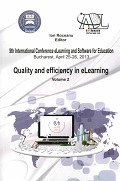A VIRTUAL LEARNING ENVIRONMENT FOR ENHANCING STUDENTS' UNDERSTANDABILITY
A VIRTUAL LEARNING ENVIRONMENT FOR ENHANCING STUDENTS' UNDERSTANDABILITY
Author(s): Aharon YadinSubject(s): Education
Published by: Carol I National Defence University Publishing House
Keywords: Visual environments; collaborative learning; personalized assignments
Summary/Abstract: This paper describes a specific course structure that was designed to increase students' understanding regarding decision making under uncertainty. The course is based on a virtual and collaborative learning environment in which the students learn, assess and analyze different approaches for solving a given problem. For that reason the course employs a visual learning environment that resembles a playing ground in which the students can "play" by controlling and monitoring the activities of a virtual robot. In addition to the virtual robot, the environment contains walls, representing obstacles and "beepers" which are small objects the robot can handle (hear them, place, pick and carry). By controlling the robot's movements while performing the predefined assignment and avoiding the obstacles, the students are exposed to various ways for addressing the problematic situation and completing the task. These playful actions help students build and enhance their analytical and problem solving skills. Addressing all available factors relevant for the decision making process is achieved by using simple "programming like" instructions that enforce accuracy and paying attention to details. In addition good learning habits are acquired by using personal and individual assignments in which each student gets a different task to perform. Furthermore, the students are also engaged in evaluating their peers' solutions which enhances their understanding by exploring other and different approaches to solve the same problem. The results obtained in this qualitative research, are based on comparing the students' grades when using the two course structures. The second course structure enhanced the students' understanding especially regarding the more abstract and unstructured issues of problem solving.
Journal: Conference proceedings of »eLearning and Software for Education« (eLSE)
- Issue Year: 9/2013
- Issue No: 02
- Page Range: 486-493
- Page Count: 8
- Language: English

